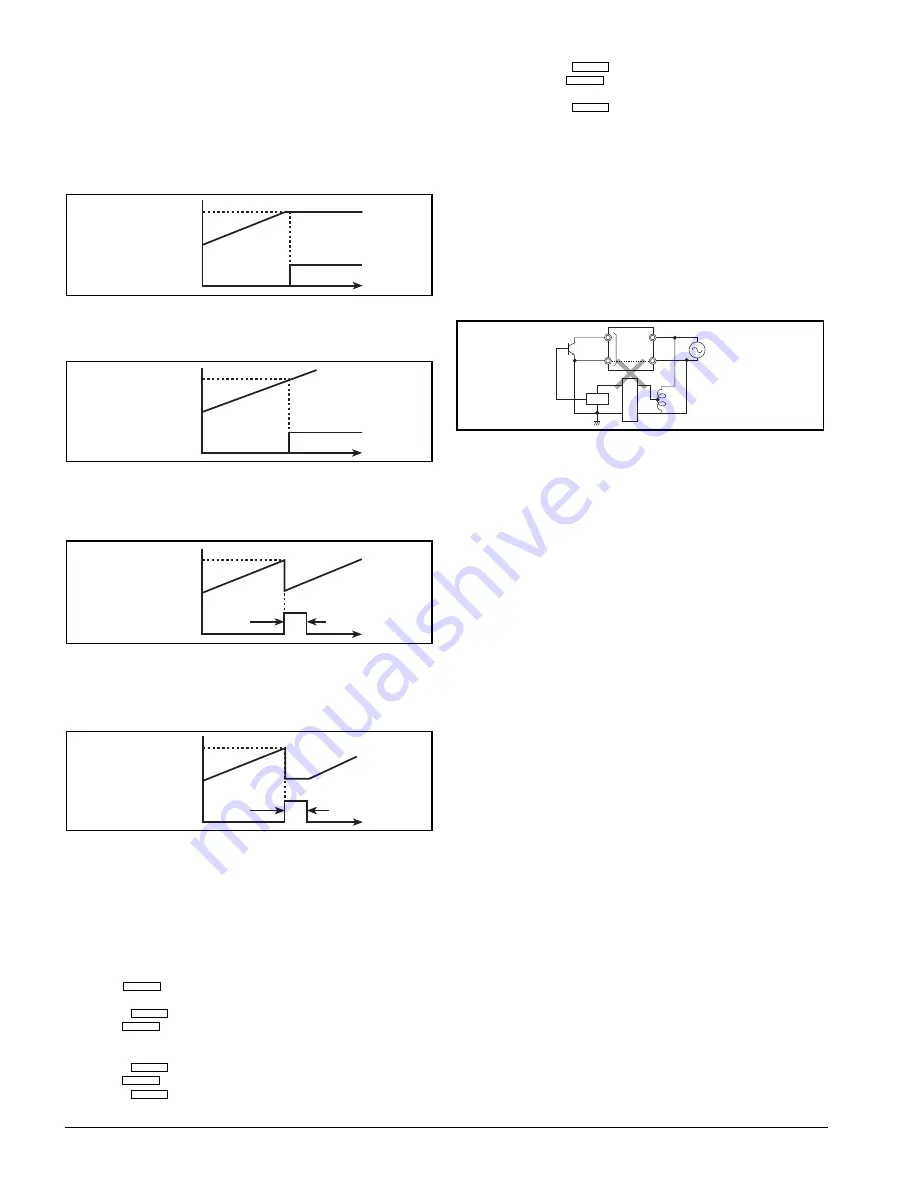
Input mode C
CP1, CP2 Quadrature inputs from shaft encoder or
similar. If CP1 leads CP2 then counter increments; if
CP2 leads CP1 then counter decrements.
Note:
Link TC should not be connected when in counter mode.
Timer
Operating mode N
The display shows the elapsed time until the set time is reached. At this
point the output is turned on the display is held. This continues until a
reset is applied.
Operating mode F
Operation is for mode N except that the display continues to show the
elapsed time when the set time is reached.
Operating mode C
The display shows the elapsed time until the set time is reached. At this
point the output is turned on for 0.5sec., the timer is reset, and timing
begins again immediately.
Note:
In this mode the unit should not be used in such a way that the set
time is reached during the timed output period.
Operating mode R
Operation is as for mode C except that the timer is held in reset until the
timed output has elapsed.
CP1
Initiates a timing sequence when the input is turned on. For single
operations only, a single pulse is required. In modes C and R a
continuous input will cause cyclic operation.
CP2
Gates the timing. When this input is on, the timing is suspended.
TC
This input controls the timing action during power supply failure. If
TC is on (connected to terminal 3) timing is suspended during
power failure; if TC is off, timing will continue regardless of the
power supply.
Setting up
1. Link terminal 1 to terminal 3
2. Use the
key to stop through the modes i.e. counter or timer
functions; hours, min, sec, are timer functions
3. Press the
key to store the displayed mode
4. Use the
key to step through the input modes A, B, and C.
Note:
Where the timer was previously selected, the display will show ‘T’
and no other mode will be possible
5. Press the
key to store the display mode
6. Use the
key to step through the output modes N, F, C and R
7. Press the
key to store the display mode
8. Disconnect terminal 1 from terminal 3
Set point
1. Ensure terminal 1 is disconnected from terminal 3
2. Press the
key
3. Use the
key to select the desired value for most
significant digit
4. Press the
key
5. Repeat steps 3 and 4 for each digit
Application notes
1. The timer can be gated through CP2, with CP1 serving as a trigger
input, to perform a time integrating function.
2. This unit uses a transformerless power supply and inputs may
therefore be at high potential. Extreme personal care should be
exercised when connecting external components. Where possible an
isolating transformer or low voltage supply should be used when
connecting to low voltage switching devices or sensors. Ensure any
devices connected to these input terminals have an insulation
appropriate to the power supply voltage.
3. The internal circuit will be destroyed when either of the two mistakes
indicated on the right figure are made. An isolating transformer is
necessary, and the input should not be earthed.
4. Programming can take with power on or off. If you have the option we
suggest power off.
5. Shorting link between 3 & 4 with TIMER function will halt the “time
out”. Terminals 3 & 4 should be open for COUNTER function.
Technical specification
Count range: ____________________________0-999999 counts
Time ranges: ______________________________0.9999.99 secs
0-99999.9 mins
0-99999.9 hours
RS
stock no.
312-353
312-369
Supply voltages:
24-240V a.c.
12-120V d.c.
Supply voltage range:
90% to 110% of rated voltage
Power consumption:
1.3VA at 240V
1W at 120V
Inrush current (0.5ms)
3.7A
2.3A
Supply frequency range:
50/60Hz
-
Supply ripple factor:
-
20% max.
Count speed:
30Hz
1kHz
Pulse width, min:
16.7ms
0.5ms
Short circuit impedance:
10k
½
max. (inputs 5,6,7) s/c current: 1mA
max.
Short circuit residual
voltage:__________________________________0.5V max. (inputs 5,6,7)
Open circuit impedance: ______500k
½
min. (inputs 5,6,7) o/c voltage:
20V max.
Reset time: __________________________________________20ms min
Repeat accuracy: ___________________0.05% ± 0.005 secs.
Setting error: ______________________________± 0.1% ± 0.005 secs.
Service life
- mechanical: ____________________________________10
7
operations
- electrical: __________________________106 operations at rated load
Output ratings: __________________
RS
stock no. 312-353: relay output,
3A resistor (SPCO)
RS
stock no. 312-369:open collector
transistor,100mA at 30V (SPNO)
Ambient working temperature: ____________________-10˚C to +55˚C
Ambient storage temperature ______________________-25˚C to +65˚C
Weight __________________________________________________112g
➞
+
➞
➞
+
➞
+
➞
+
0.5s
0.5s
set
Figure 7
display
output
time
set
Figure 8
display
output
time
set
Figure 5
display
output
time
set
Figure 6
display
output
time
Circuit
Power
Auto-transformer
Rectifier
circuit
The information provided in
RS
technical literature is believed to be accurate and reliable; however, RS Components assumes no responsibility for inaccuracies or
omissions, or for the use of this information, and all use of such information shall be entirely at the user’s own risk.
No responsibility is assumed by RS Components for any infringements of patents or other rights of third parties which may result from its use.
7798


